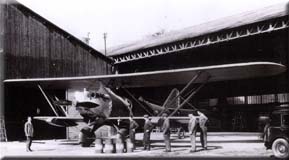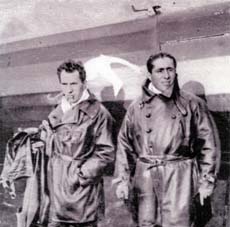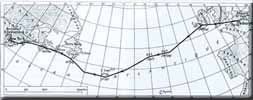
 |
|

| The crew |

|
Dieudonné Costes
Dieudonné Costes was born in Septfonds, Tarn-et-Garonne, in Southern France, in 1892. As a child he was soon a mechanical buff and was a brilliant student in Mathematics. He became interested in automobiles although aviation became his passion. During World War One he flew as a pilot in the Near East where he became an 'ace' flying bombers. He was mentioned in despatches eleven times and decorated with the Medaille Militaire and the Legion d'Honneur. As an airline pilot after the war, his usual route was Paris to London or Paris to Casablanca, Morocco. As a record pilot he became the best in the world, his main feats being Paris to Assouan (4100 km, 2562 miles) non-stop with De Vitrolle as navigator, Paris to Calcutta in 1926 and Paris to Djask (5306km, 3316 miles) both with M. Rignot as navigator. He also flew Paris to Nijni-Tajilsk (5000 km, 3125 miles) in 1926, a round the world flight of 57000 km (35625 Miles) with Le Brix, the first non stop South Atlantic crossing and a flight from Tokyo in less than four days. Then, at last, Paris to New York non-stop in 37 hours between 1 and 2 September 1930.
|
Maurice Bellonte
Born in 1896 in Méru (Oise) Northern France he was already a veteran at the time of the flight attempt with 20 years of experience in aviation. He flew for six years as a flight mechanic, navigator and radio operator on transcontinental routes such as Paris to London, Paris to Brussels and Paris to Marseilles boasting more than 3500 flight hours since 1922.
Bellonte was able to take the same risks as the pilots and could cope with all situations. He walked the wing of the aeroplane five times to fix problems, thus risking his life. He and pilot Delelse ditched on November 14 1925 and managed to save his life by radioing a mayday to merchant ships sailing in the North Sea.
He successfully got his navigator/mechanic licence and then his public transport mechanic licence along with his navigator's licence restored by the Aero Club de France in 20 September 1923 and eventually his pilot's licence upon his return from the Paris to Tsitsikar world record breaking flight (7925 km).
|
| The " Point d'Interrogation", a very special airplane |
Two assumption for her name :
On the airfield, this aircraft was known with the nickname "Le Rouge" (the red one).
A high performance aircraft, it is part of a tiny production run of just five machines, designed and built for long distance flights and based on the Breguet XIX. This aeroplane has been specially modified aiming at just one goal, the non-stop trans Atlantic flight.
The distance between the wings and the wingspan was increased by adding a cabane and the original one-strut arrangement was supplemented by two self-contained strut, rigged with steel wired; The two cockpits were equipped with the most up-to-date instruments and, notably, an artificial horizon...
The big day was 13 July 1929. Then crew took off for the crossing but the attempt was aborted due to bad weather conditions over the Azores. The flight was, none the less, good experience and the engine power was increased form 600 to 650 horsepower.
On 27 September 1929 the same crew took off again although this time to the east, aiming to break the world distance record. They eventually landed on the 29th in Manchuria after a non-stop flight of 8000km (5000 miles).
This was enough to claim the record and provided even more inspiration for them to cross the Atlantic.
| The first east to west crossing of the Atlantic |

On 1 September 1930, the point d'Interrogation took off at last from Le Bourget airport after several months of intensive preparation. With an exceptionally good North Atlantic weather forecast, Costes favoured an early dawn take off but was forced to wait as fog developed over Paris. They waited until ten o'clock when they got the green light from their friend Codos who was flying weather missions for them.
The aeroplane was pulled from the hanger and parked at the very end of the field where both men climbed aboard.
At 10:54, Costes opened the throttle and the big aeroplane lifted slowly into the now clear sky, and set course for Ecouen at hardly 200 metres (650 feet ) above the ground. At 11 o'clock it was spotted pointing towards the British Isles close to Les Andelys, now flying at 1100 metres (3500 feet). The two men talk to each other with small hand written pieces of paper.
The first radio message was received at 11:48 and their position was between Cap d'Antifer and Barfleur. Their airspeed was 210 kph. The Breguet left French soil at Le Crotoy and flew over the Canal St George at 14:45, and reached the ocean with an altitude of 400-500 metres at a position 52 deg latitude and 12 deg 20 m West.
Between 19:00 and 22:00, the aeroplane had to change course, flying north and then south again between 22:00 and 04:35 the next morning to avoid bad weather before resuming its direct course.
At 11:25, 24 hours after leaving, a message was received at Saint Pierre and it was sighted off the coast of Boston, Mass, entering a stormy area.
It eventually landed at Curtiss Field at 00:11 completing the first East-West transatlantic crossing, flying against the prevailing winds, in 37 hours averaging a speed of 167 kmh.
As soon as they got out of the aeroplane they were carried on the shoulders of an enthusiastic welcome party to the hanger where all French personalities in New York were waiting to greet them. Among them were Alain Gerbault and tennis player Jean Borotra. All of a sudden Costes and Bellonte noticed a tall man smiling at them from the corner of the hanger. The young man was Charles Lindberg coming to congratulate them. They realised at once they had also become legends.


